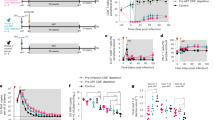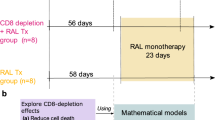Abstract
SIV-infected macaques exhibit distinct rates of progression to AIDS and despite significant increases in CD8+ T cells, immune cells fail to control and eradicate SIV in vivo. Here, we investigated the interplay between viral reservoir sites, CD8+ T-cell activation/death and outcome. Our data provide strong evidence that mesenteric (Mes) lymph nodes represent major reservoirs not only for SIV-infected macaques progressing more rapidly toward AIDS but also in controllers. We demonstrate that macaques progressing faster display greater expression of TGF-β and Indoleamine 2,3 dioxygenase in particular in intestinal tissues associated with a phosphorylation of the p53 protein on serine 15 in CD8+ T cells from Mes lymph nodes. These factors may act as a negative regulator of CD8+ T-cell function by inducing a Bax/Bak/Puma-dependent death pathway of effector/memory CD8+ T cells. Greater T-cell death and viral dissemination was associated with a low level of TIA-1+ expressing cells. Finally, we provide evidence that abrogation of TGF-β in vitro enhances T-cell proliferation and reduces CD8+ T-cell death. Our data identify a mechanism of T-cell exhaustion in intestinal lymphoid organs and define a potentially effective immunological strategy for the modulation of progression to AIDS.
Similar content being viewed by others
Log in or create a free account to read this content
Gain free access to this article, as well as selected content from this journal and more on nature.com
or
Abbreviations
- AIDS:
-
Acquired Immunodeficiency Syndrome
- SIV:
-
Simian Immunodeficiency Virus
- HIV:
-
Human Immunodeficiency Virus
- LN:
-
lymph node
- IDO:
-
indoleamine 2,3 dioxygenase
- GALT:
-
gut-associated lymphoid tissue
- PD-1:
-
programmed death 1
- AICD:
-
activation-induced cell death
- CTL:
-
cytotoxic T lymphocyte
References
Blankson JN, Persaud D, Siliciano RF . The challenge of viral reservoirs in HIV-1 infection. Annu Rev Med 2002; 53: 557–593.
Schmitz JE, Kuroda MJ, Santra S, Sasseville VG, Simon MA, Lifton MA et al. Control of viremia in simian immunodeficiency virus infection by CD8+ lymphocytes. Science 1999; 283: 857–860.
Hurtrel B, Petit F, Arnoult D, Muller-Trutwin M, Silvestri G, Estaquier J . Apoptosis in SIV infection. Cell Death Differ 2005; 12(Suppl 1): 979–990.
Pantaleo G, Graziosi C, Demarest JF, Butini L, Montroni M, Fox CH et al. HIV infection is active and progressive in lymphoid tissue during the clinically latent stage of disease. Nature 1993; 362: 355–358.
Veazey RS, DeMaria M, Chalifoux LV, Shvetz DE, Pauley DR, Knight HL et al. Gastrointestinal tract as a major site of CD4+ T cell depletion and viral replication in SIV infection. Science 1998; 280: 427–431.
Heise C, Vogel P, Miller CJ, Halsted CH, Dandekar S . Simian immunodeficiency virus infection of the gastrointestinal tract of rhesus macaques. Functional, pathological, and morphological changes. Am J Pathol 1993; 142: 1759–1771.
Estes JD, Li Q, Reynolds MR, Wietgrefe S, Duan L, Schacker T et al. Premature induction of an immunosuppressive regulatory T cell response during acute simian immunodeficiency virus infection. J Infect Dis 2006; 193: 703–712.
Schacker TW, Nguyen PL, Beilman GJ, Wolinsky S, Larson M, Reilly C et al. Collagen deposition in HIV-1 infected lymphatic tissues and T cell homeostasis. J Clin Invest 2002; 110: 1133–1139.
Kingsley DM . The TGF-beta superfamily: new members, new receptors, and new genetic tests of function in different organisms. Genes Dev 1994; 8: 133–146.
O'Garra A, Vieira P . Regulatory T cells and mechanisms of immune system control. Nat Med 2004; 10: 801–805.
Mellor AL, Munn DH . IDO expression by dendritic cells: tolerance and tryptophan catabolism. Nat Rev Immunol 2004; 4: 762–774.
Cordenonsi M, Dupont S, Maretto S, Insinga A, Imbriano C, Piccolo S . Links between tumor suppressors: p53 is required for TGF-beta gene responses by cooperating with Smads. Cell 2003; 113: 301–314.
Monceaux V, Ho Tsong Fang R, Cumont MC, Hurtrel B, Estaquier J . Distinct cycling CD4(+)- and CD8(+)-T-cell profiles during the asymptomatic phase of simian immunodeficiency virus SIVmac251 infection in rhesus macaques. J Virol 2003; 77: 10047–10059.
Sachsenberg N, Perelson AS, Yerly S, Schockmel GA, Leduc D, Hirschel B et al. Turnover of CD4+ and CD8+ T lymphocytes in HIV-1 infection as measured by Ki-67 antigen. J Exp Med 1998; 187: 1295–1303.
Ishida Y, Agata Y, Shibahara K, Honjo T . Induced expression of PD-1, a novel member of the immunoglobulin gene superfamily, upon programmed cell death. EMBO J 1992; 11: 3887–3895.
Barber DL, Wherry EJ, Masopust D, Zhu B, Allison JP, Sharpe AH et al. Restoring function in exhausted CD8 T cells during chronic viral infection. Nature 2006; 439: 682–687.
Monceaux V, Viollet L, Petit F, Ho Tsong Fang R, Cumont MC, Zaunders J et al. CD8+ T cell dynamics during primary simian immunodeficiency virus infection in macaques: relationship of effector cell differentiation with the extent of viral replication. J Immunol 2005; 174: 6898–6908.
Gunnlaugsdottir B, Maggadottir SM, Ludviksson BR . Anti-CD28-induced co-stimulation and TCR avidity regulates the differential effect of TGF-beta1 on CD4+ and CD8+ naive human T-cells. Int Immunol 2005; 17: 35–44.
Jin X, Bauer DE, Tuttleton SE, Lewin S, Gettie A, Blanchard J et al. Dramatic rise in plasma viremia after CD8(+) T cell depletion in simian immunodeficiency virus-infected macaques. J Exp Med 1999; 189: 991–998.
Migueles SA, Laborico AC, Shupert WL, Sabbaghian MS, Rabin R, Hallahan CW et al. HIV-specific CD8+ T cell proliferation is coupled to perforin expression and is maintained in nonprogressors. Nat Immunol 2002; 3: 1061–1068.
Betts MR, Nason MC, West SM, De Rosa SC, Migueles SA, Abraham J et al. HIV nonprogressors preferentially maintain highly functional HIV-specific CD8+ T cells. Blood 2006; 107: 4781–4789.
Reimann KA, Parker RA, Seaman MS, Beaudry K, Beddall M, Peterson L et al. Pathogenicity of simian-human immunodeficiency virus SHIV-89.6P and SIVmac is attenuated in cynomolgus macaques and associated with early T-lymphocyte responses. J Virol 2005; 79: 8878–8885.
Ling B, Veazey RS, Luckay A, Penedo C, Xu K, Lifson JD et al. SIV(mac) pathogenesis in rhesus macaques of Chinese and Indian origin compared with primary HIV infections in humans. AIDS 2002; 16: 1489–1496.
George MD, Verhoeven D, McBride Z, Dandekar S . Gene expression profiling of gut mucosa and mesenteric lymph nodes in simian immunodeficiency virus-infected macaques with divergent disease course. J Med Primatol 2006; 35: 261–269.
Shacklett BL, Cox CA, Quigley MF, Kreis C, Stollman NH, Jacobson MA et al. Abundant expression of granzyme A, but not perforin, in granules of CD8+ T cells in GALT: implications for immune control of HIV-1 infection. J Immunol 2004; 173: 641–648.
Arnoult D, Petit F, Lelievre JD, Lecossier D, Hance A, Monceaux V et al. Caspase-dependent and -independent T-cell death pathways in pathogenic simian immunodeficiency virus infection: relationship to disease progression. Cell Death Differ 2003; 10: 1240–1252.
Estaquier J, Idziorek T, Zou W, Emilie D, Farber CM, Bourez JM et al. T helper type 1/T helper type 2 cytokines and T cell death: preventive effect of interleukin 12 on activation-induced and CD95 (FAS/APO-1)-mediated apoptosis of CD4+ T cells from human immunodeficiency virus-infected persons. J Exp Med 1995; 182: 1759–1767.
Estaquier J, Tanaka M, Suda T, Nagata S, Golstein P, Ameisen JC . Fas-mediated apoptosis of CD4+ and CD8+ T cells from human immunodeficiency virus-infected persons: differential in vitro preventive effect of cytokines and protease antagonists. Blood 1996; 87: 4959–4966.
Wasem C, Arnold D, Saurer L, Corazza N, Jakob S, Herren S et al. Sensitizing antigen-specific CD8+ T cells for accelerated suicide causes immune incompetence. J Clin Invest 2003; 111: 1191–1199.
Kekow J, Wachsman W, McCutchan JA, Cronin M, Carson DA, Lotz M . Transforming growth factor beta and noncytopathic mechanisms of immunodeficiency in human immunodeficiency virus infection. Proc Natl Acad Sci USA 1990; 87: 8321–8325.
Terabe M, Matsui S, Park JM, Mamura M, Noben-Trauth N, Donaldson DD et al. Transforming growth factor-beta production and myeloid cells are an effector mechanism through which CD1d-restricted T cells block cytotoxic T lymphocyte-mediated tumor immunosurveillance: abrogation prevents tumor recurrence. J Exp Med 2003; 198: 1741–1752.
Bronte V, Wang M, Overwijk WW, Surman DR, Pericle F, Rosenberg SA et al. Apoptotic death of CD8+ T lymphocytes after immunization: induction of a suppressive population of Mac-1+/Gr-1+ cells. J Immunol 1998; 161: 5313–5320.
Cerwenka A, Swain SL . TGF-beta1: immunosuppressant and viability factor for T lymphocytes. Microbes Infect 1999; 1: 1291–1296.
Day CL, Kaufmann DE, Kiepiela P, Brown JA, Moodley ES, Reddy S et al. PD-1 expression on HIV-specific T cells is associated with T-cell exhaustion and disease progression. Nature 2006; 443: 282–283.
Trautmann L, Janbazian L, Chomont N, Said EA, Wang G, Gimmig S et al. Upregulation of PD-1 expression on HIV-specific CD8+ T cells leads to reversible immune dysfunction. Nat Med 2006; 12: 1198–1202.
Petrovas C, Casazza JP, Brenchley JM, Price DA, Gostick E, Adams WC et al. PD-1 is a regulator of virus-specific CD8+ T cell survival in HIV infection. J Exp Med 2006; 203: 2281–2292.
Parry RV, Chemnitz JM, Frauwirth KA, Lanfranco AR, Braunstein I, Kobayashi SV et al. CTLA-4 and PD-1 receptors inhibit T-cell activation by distinct mechanisms. Mol Cell Biol 2005; 25: 9543–9553.
Silvestri G, Sodora DL, Koup RA, Paiardini M, O'Neil SP, McClure HM et al. Nonpathogenic SIV infection of sooty mangabeys is characterized by limited bystander immunopathology despite chronic high-level viremia. Immunity 2003; 18: 441–452.
Garber DA, Silvestri G, Barry AP, Fedanov A, Kozyr N, McClure H et al. Blockade of T cell costimulation reveals interrelated actions of CD4+ and CD8+ T cells in control of SIV replication. J Clin Invest 2004; 113: 836–845.
Monceaux V, Estaquier J, Fevrier M, Cumont MC, Riviere Y, Aubertin AM et al. Extensive apoptosis in lymphoid organs during primary SIV infection predicts rapid progression towards AIDS. AIDS 2003; 17: 1585–1596.
Acknowledgements
The authors are grateful to Dr. J Berzofsky (National Cancer Institute, Bethesda, USA) and Dr. Y Lévy (Hôpital Henri-Mondor, Créteil, France) for critically reading the manuscript and for helpful comments. We also acknowledge JM Panaud (Institut Pasteur) for pictures and AM Aubertin (INSERM U-74, Strasbourg) for kindly providing virus. We apologize to the authors of relevant articles that are not cited because of space limitations. This work was funded by grants from the Agence Nationale de la Recherche sur le Sida (ANRS) and Fondation de la Recherche Médicale (FRM) to JE. VL was supported by a fellowship from ANRS and LS by a postdoctoral fellowship from SIDACTION.
Author information
Authors and Affiliations
Corresponding author
Additional information
Edited by G Rabinovich
Supplementary Information accompanies the paper on Cell Death and Differentiation website (http://www.nature.com/cdd)
Supplementary information
Rights and permissions
About this article
Cite this article
Cumont, M., Monceaux, V., Viollet, L. et al. TGF-β in intestinal lymphoid organs contributes to the death of armed effector CD8 T cells and is associated with the absence of virus containment in rhesus macaques infected with the simian immunodeficiency virus. Cell Death Differ 14, 1747–1758 (2007). https://doi.org/10.1038/sj.cdd.4402192
Received:
Revised:
Accepted:
Published:
Issue date:
DOI: https://doi.org/10.1038/sj.cdd.4402192
Keywords
This article is cited by
-
T cell apoptosis characterizes severe Covid-19 disease
Cell Death & Differentiation (2022)
-
Despite early antiretroviral therapy effector memory and follicular helper CD4 T cells are major reservoirs in visceral lymphoid tissues of SIV-infected macaques
Mucosal Immunology (2020)
-
Mucosal T follicular helper cells in SIV-infected rhesus macaques: contributing role of IL-27
Mucosal Immunology (2019)
-
Regulation of immunity during visceral Leishmania infection
Parasites & Vectors (2016)
-
Exploring NAD+ metabolism in host–pathogen interactions
Cellular and Molecular Life Sciences (2016)



